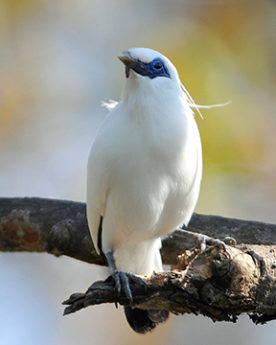In het noordwesten van het Indonesische eiland Bali is het Taman Nasional Barat Bali. (Nationaal park West-Bali). Met 770 m² natuur beslaat het qua grootte ongeveer 10 % van het eiland. Er leven 160 diersoorten en vele plantensoorten.
Een van de beroemdste vogels in het park is de Balispreeuw. De Leucopsar Rothschildi is met uitsterven bedreigd. In 2008 waren er in het wild nog ongeveer 50 exemplaren. Na een uitgebreid fokprogramma met medewerking van onder andere dierentuinen wil het nog steeds niet zo lukken de populatie te laten groeien. Wildvang, speciaal leefgebied dat kleiner word door aanleg van kokos- en kapokplantages en dorpsuitbreidingen helpen niet.
Samen met m’n Balinese chauffeur/gids en vooral ook vriend Putu heb ik het park bezocht. Omdat het park nogal afgelegen ligt van de toeristenoorden hebben we in het nabij gelegen resort eerst gegeten en geslapen om de volgende morgen fris de tocht bij zonsopgang te beginnen. Na vijf uren gedwaald te hebben door het gebied in de zinderende hitte van de zon maar ook de opgewarmde lavabodem hoorden we de baltsroep van de Balispreeuw. Voor een vogelaar is het moment van het eerste zicht op de met uitsterven bedreigde vogel in het wild een enorme kick.
De prachtige witte vogel met z’n zwarte vleugel- en staartuiteinden en de karakteristieke blauwe huid rond de ogen. We zagen vier exemplaren in de bomen en ik had het geluk een paartje te fotograferen.
Om nooit te vergeten.
BALI BARAT, THE BALI STARLING
In the northwest of the Indonesian Island Bali lies the Taman Nasional Barat Bali, a National park. The park is 770 square meters, and covers about 10% of the island. It has 160 species of animals and many kinds of plants.
One of the most famous birds in the park is the Bali starling. The Leucopsar Rothschildi is critically endangered, and in 2008 there were only 50 birds left. After extended regulated captive-breeding programs in co-operation with zoos, it still is a struggle to gain birds. Catching them illegally, habitat reduced by coconut- and kapok plantations and the extending of villages do not help.
Together with my driver/guide, but most of all my friend Putu I visited the park. Because the park is remote from all tourist areas we ate and slept first to arrive freshly at sunrise the next morning. So we started our expedition. After first wandering around in the sizzling heat for five hours (heat from the sun but also the heated up lavagrounds), we finally heard the mating call from the Bali starling. For a birdwatcher, tot hear a cry from an almost extinct bird, this is a huge thrill!
The beautiful white bird with it’s black wing- and tail tips, and characteristic blue skin around the eyes. mWe eventually saw four of them in the trees and I was lucky enough to photographed a pair.
I will never ever forget this.




